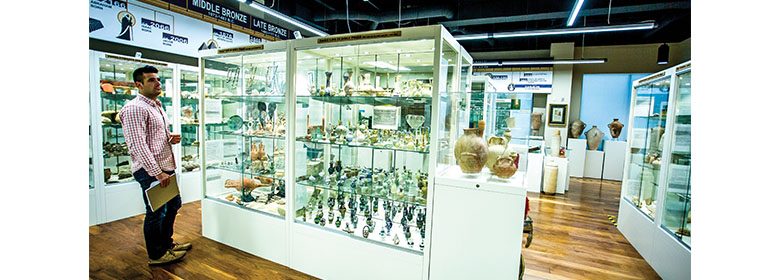Liberty Biblical Museum offers insight into Biblical history

- Students who don’t want to wait for the Museum of the Bible to open can visit Liberty’s Biblical Museum.
- Biblical Museum offers chance for students and public to put biblical events into historical perspective.
Throughout their education, many Liberty University students will find themselves studying the history of Scripture or learning about the ancient civilizations of the Bible. If concepts from biblical history are difficult to grasp, the university’s Biblical Museum is available to help bridge the gap from the past 2,000 years to today.
Largely the result of the museum’s curator, Dr. Randall Price, and his private collection of biblical artifacts, the Liberty Biblical Museum allows students to actually walk through time and witness the glory of civilizations long gone. From displays of Roman armor and weapons to an exhibit of the Dead Sea Scrolls, the museum offers the opportunity to connect lessons learned in New Testament class with real tools from the time of Jesus and earlier.
Price believes the exhibits are the key to a student’s understanding of the Bible’s past.
“Students have all of a sudden come to understand that they’re looking at pieces that are thousands of years old, from the very place and time where the Bible said it happened, and something changes,” Price said. “There’s a perception that says, ‘Wow, this place is real; this really happened.’ So instead of having a storybook faith, they have a real faith. And that’s what I want.”
Price’s interest in the history of the Bible began when he became a believer at 16 and studied the Bible at seminary, desiring to confirm for himself the events captured in God’s Word. Price moved to Jerusalem to attend a Hebrew university, and found himself surrounded by history. The direct encounter with biblical antiquity inspired him to start a collection of artifacts in order to bring the reality of the Bible to others, recreating the experience at Liberty with free access to the public.
One of Price’s personal favorite artifacts is an actual stone from the second temple in the time of Jesus, which is likely the only one found in the United States. Other notable exhibits include the Last Supper exhibit, a sickle sword of the kind Joshua likely used to conquer Jericho and a pair of leather sandals worn in the first century.
“We have the museum arranged in such a way that you can walk through biblical history. There’s a little bit of a favorite in every area of history,” Price said. “We put up a timeline just this summer that allows students to look at the artifacts and put them into the flow of biblical history up to our time.”
National interest in biblical history has been on the rise as well, as evidenced by the construction of the future Museum of the Bible in Washington D.C. While the project will feature far greater space than Liberty’s Biblical Museum, Price’s collection is more concerned with the artifacts themselves rather than manuscripts.
Additionally, the Biblical Museum is accessible, is free to the public and provides an impressive variety of archaeology in a comfortable space.
Price said he personally embarks on expeditions with students to dig sites where new items can be discovered, processed, and brought to the museum for the student body to enjoy.
“The goal is to increase students’ awareness and appreciation of the Bible,” Price said, “and to have an encounter with the world of the Bible that leads to a personal experience of faith and the God of the Bible.”
The Liberty Biblical Museum is located behind the stairs on the terrace level of the Jerry Falwell Library and is open during the week for public viewing. Guided tours for larger groups are available upon prior request.
